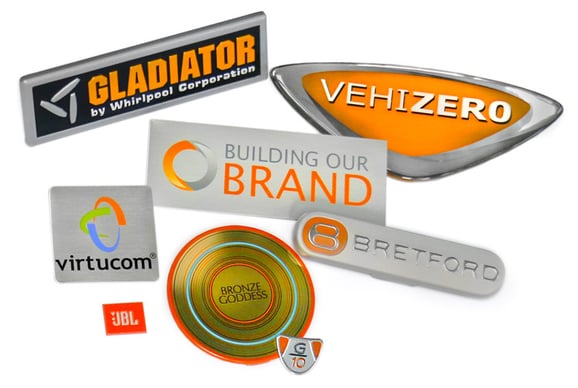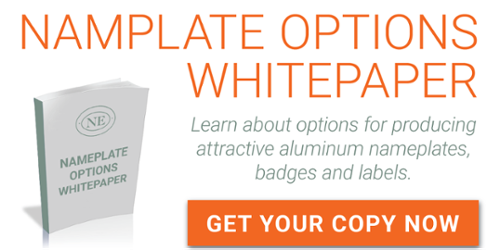Nameplate Litho Printing FAQ
Offset Lithography in Nameplates

Offset lithography or litho printing is one of the workhorses of aluminum decoration for nameplates and emblems. It is easily combined with other decorative processes such as: brushing, spinning, screen printing, embossing, diamond cutting and doming. One of the major advantages of offset lithography is the tight registration which can be achieved. It is also the preferred option when working with halftones and fine detail. Following is a Q & A focusing on the litho process as it is used in the decoration of nameplates.
Frequently Asked Questions | Nameplate Printing
Q: Can you print on a formed part?
A: All of our decoration is applied in the flat sheet. Forming and tooling happens after decoration.
Q: How can I add depth to a color?
A: Adding a mechanical finish under transparent colors is one way to add depth to a color.
Q: What registration can you hold color to color using lithography?
A: Standard registration between lithography colors is .005". This can vary depending on the design and therefore is reviewed on a case by case basis.
Q: What is the minimum stroke needed on positive graphics?
A: A minimum of .005" stroke width is required for positive printing and .008" for screening.
Q: What is the minimum stroke needed for reverse graphics or background printing?
A: When printing a background color or negative printing, a minimum of .008" stroke width is required.
Q: How do you print two transparent colors next to each other and minimize registration issues?
A: Transparent colors which sit next to each other are flared, causing a slight overlap between the colors. This overlap can create a "halo" effect. To resolve this, a solid separator line is generally recommended.
Q: What do you use to protect offset lithography decoration?
A: All of our litho printing is protected by a clear topcoat which also determines the finished gloss level.
Q: Can the nameplate be used for exterior applications?
A: The topcoat that is applied to the nameplate determines what specs it would pass. Be sure to indicate in your artwork or request for quote if you have an exterior or harsh environment so that appropriate process and coating can be reviewed.
Q: How do you match a finely detailed scratched or distressed look on a nameplate or in decorative trim?
A: Fine detail and any printing requiring halftones is achieved through offset lithography. There are a number of existing patterns with a distressed or patinaed look for use as seen or customizable for your specific needs.
Q: What considerations are there for printing a very light pastel color?
A: An additional base or ground color may be required for printing very light colors. This is because the aluminum substrate may be too dark and darken the light color.
Q: What is the Pantone Matching System?
A: The Pantone Matching System is an international standard referring to color. It is more commonly referred to as PMS colors.
Q: What resolution do you use for four color printing?
A: Production printing is done at 200 dpi which results in a standard resolution of 300 dpi or higher for the digital file.
Q: What light source should be used for viewing color?
A: The standard for nameplate color review is cool white and for automotive trim is daylight. This can vary depending on the environment in which the nameplate or trim is found.
Q: What is a prep or prepartion charge that is seen on quotations?
A: A preparation charge is assessed for first time runs and design changes. This is for the artwork generated to make the litho plate or screen. One prep is required for each color or resist operation. The cost per prep is dependent on the process used.
Q: Can I have multiple gloss levels on my nameplate?
A: Yes. Multiple gloss levels can be applied to nameplates and decorative trim.
Q: Are there benefits to litho over screening process for nameplates and trim decoration?
A: Offset lithography is typically the recommended process when there are fine detail or graphics needed for the nameplate or trim. In addition, lithography and process color are used for the reproduction of full color photos.
Q: What metal substrates do you print on?
A: Our standard metal substrate is aluminum. We can simulate the look of most metals including brass and stainless steel using this material. If your application requires stainless steel, we can also work with type 304 and 430.
Q: Are there other processes that will give a similar look to lithography?
A: Yes. Both screening and coating can be used for overall colors. Screening can also be used for most selective colors and some graphics.
Q: Can lithography be combined with other processes?
A: Yes. Some of these include: mechanical finishes, screening, doming and diamond cutting.
Q: What considerations would steer you towards litho instead of screening?
A: Capacity, volume, color, registration and graphics are all factors in determining the recommended decorating process for producing nameplates and trim.
Q: What do you use to help assure consistency when you run a pattern, four color process or wood grain?
A: A manufacturing process card provides the decoration details with unique color, gloss and tool information. This is used as the guide when running any production job to ensure quality and consistency.
Q: What considerations are there for determining the number of hits for a color?
A: Color, opacity and graphics are all factors in determining the number of hits or passes that are needed to achieve the desired result.
Q: What determines when printing steps are required to run a job?
A: Typically we keep steps for woodgrain, four color process and pattern designs to verify the layers of color as the finish is created and then reproduced in production runs.
Editor’s note: This post was originally published in February 2010 and has been completely revamped and updated for accuracy and comprehensiveness.
Still have questions about printing processes used to produce nameplates, labels and decorative trim? Let's talk!
Subscribe to Nameplate Blog
- 2021 (1)
- 3D (4)
- Adhesives (11)
- Aluminum (129)
- Aluminum In-mold (9)
- Aluminum Trim (41)
- Anodize (4)
- Appliance (12)
- Appliqué (5)
- Archive (35)
- Artwork Submission (4)
- Assembly (6)
- Automotive (35)
- Backlit (5)
- Boats (6)
- Brass (8)
- Brushed Aluminum (19)
- Carbon Fiber (2)
- Classic (1)
- Coined (5)
- Color Development (25)
- Computers (13)
- Cosmetics (24)
- Custom Patterns (11)
- Customization (16)
- Customized Patterns on Aluminum (2)
- Debossing (13)
- Diamond Cut (22)
- Digital Printing (2)
- ebook (4)
- Electronics (23)
- Embossing (53)
- Etched (20)
- Exterior (9)
- FAQ (29)
- Faux Finish (1)
- Faux Finishes (7)
- Favorite Nameplate (20)
- Furniture (9)
- Gauges (5)
- Gloss (4)
- Hang Tag (1)
- IDSA (1)
- In-mold Decoration (5)
- Individual Letters (7)
- Inlay (1)
- Key Fob (1)
- Labels (10)
- Large Vehicle (4)
- Laser Etch (2)
- Lithography (3)
- Match Box Cover (6)
- Materials and Processes (118)
- Mechanical Finishes (51)
- Medical Equipment (10)
- Metallic (8)
- Motorcycle (11)
- Nameplate (175)
- Nameplate Examples (54)
- Nameplate Tools (7)
- Outdoor Equipment (4)
- Overlay (7)
- Packaging (15)
- Patina Finish (3)
- Plastic (1)
- Plastic Trim (3)
- Point of Purchase (8)
- Polycarbonate (10)
- Process Color (16)
- Promotional Products (38)
- Prototypes (2)
- Recreational Vehicles (6)
- Resources (11)
- Safety Labels (2)
- Selective Patterns (10)
- Sill Plate (6)
- Sports Equipment (9)
- Stainless Steel (17)
- stock dies (10)
- Surfaces (4)
- Sustainability (1)
- Technical (1)
- Telecommunications (9)
- Testing (3)
- Texture (15)
- Top 10 (9)
- Woodgrain (2)






